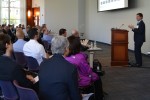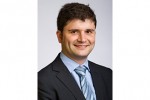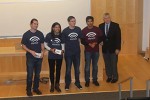News & Events
ALERT Newsletter
ALERT Featured in DHS Science & Technology Newsroom August 29, 2016
The ALERT Center of Excellence works closely with industry partners like Detectachem and first responders to develop technologies and algorithms to enhance the ability to eliminate illicit explosives.
This month, ALERT was featured in the DHS S&T’s Responder Newsroom highlighting its improvement of explosives training solutions for first responders. The feature showcases ALERT’s work with K-9 explosive detection training aids (TEAS).
ADSA15: Save the Date! August 19, 2016

The Fifteenth Advanced Development for Security Applications Workshop (ADSA15) will be held on November 15th and 16th at Northeastern University in Boston, Massachusetts. The title of the workshop will be “Next Generation Screening Technologies and Processes for the Checkpoint.” This workshop is a continuation of ADSA12, ADSA13, and ADSA14. The workshop is being convened by the DHS Center of Excellence (COE) for Awareness and Localization of Explosives-Related Threats (ALERT).
Presentation and panel discussions will address the following topics:
- Emerging hardware and algorithms
- Concepts of operations
- Protecting soft targets
- Data analytics – application to aviation security
- System architectures
- Business aspects of fusion
- Funding, innovation and deployment models
For more information on the ADSA workshops, visit our ADSA Workshop Page
This workshop is by invitation only.
If you are interested in learning more, or receiving an invitation, please contact Melanie Smith at [email protected].
Fundamentals of Explosives and Detonation & DDT Courses June 29, 2016
Fundamentals of Explosives Course
A Fundamentals of Explosives course is being offered in Los Alamos, NM, August 1-3, 2016. This course is intended to help each student understand basic behaviors of explosives, how they detonate, and the effects of detonation. It provides a foundation for study of specific aspects of explosives work, from safety in handling and testing, to logistical, research, development, design and analysis functions.
Detonation & DDT Course
A Detonation & DDT course is being offered in Los Alamos, NM, September 20-22, 2016. This class will be conducted at a graduate level. Class members will learn the capabilities and limitations of each of these models, and how to apply them where they are useful. In addition, ways to design experiments to investigate behaviors for both fundamental and applied design or analysis purposes will be discussed with the class.
For more information about these courses, please reach out directly to ALERT researcher, Dr. Jimmie Oxley or Dr. James Kennedy:
Prof. Jimmie C. Oxley, [email protected].
Dr. James Kennedy, [email protected].
ALERT Demos Tech at Centers of Excellence Technology Showcase June 28, 2016

June 28, 2016
ALERT brought its advances in explosives detection research to the 2016 Centers of Excellence Technology Showcase in Washington D.C. last month. The event featured “Chat with an Expert” sessions, informational tables for each center, information on training opportunities, and live demonstrations. The Department of Homeland Security, Science and Technology Directorate, Office of University Programs hosted the showcase at the Ronald Reagan Building in Washington D.C. for over 250 government agencies and first responders.
Professor Jimmie Oxley represented ALERT in one of the “Chat with an Expert” sessions, which allowed participants to have 10 minutes of one-on-one time with each expert to discuss specific technologies, center research, or opportunities for partnership. Professor Oxley also led ALERT’s live demo of the day: “Trace Explosives Aids for Scent (TEAS).” Her research team developed a method of polymer encapsulation that is used to create safe trace explosives sources. Their research results show that Polycarbonate microspheres containing only a low percentage of Triacetone Triperoxide (TATP) last for years, yet produce pure TATP vapor when heated at the designated program rate. Although they contain small amounts of actual explosives material, these TEAS are called pseudo-explosives because they have no potential to explode, thus providing users with safe access to stored hazardous explosives at trace levels for the purpose of training K-9s and calibrating instrumentation.
Currently, 29 groups have tested prototypes of ALERT’s training aids, including NY MTA Police, MA State Police, Toronto Police, and industry collaborators such as K-9 Search On Site, and FLIR Systems, Inc.
The Live Demo
Officer William Qualls and his K-9 partner, Nate, demonstrated how they use TEAS in the field by having attendees hide one of the activated TEAS somewhere in the Showcase space and then having Nate work to find it. Travis Kisner, Director of Engineering from Detectachem, presented the microsphere heater Detectachem developed for use with ALERT’s TEAS.
ALERT’s Research and Networking with End Users
ALERT team members, Emel Bulat (Industry Liaison) and Deanna Beirne (Director of Computer Services), presented ALERT technologies and center capabilities to the broad showcase audience. Center tools like VAST, PIMS and MVCTC were highlighted by the team and were of great interest to the participants. Videos and Fact Sheets for each tool were also on display.
The event resulted in dozens of connections for the center and a better understanding of what challenges end users like U.S. Customs and Border Protection and the Transportation Security Administration are facing. ALERT is looking forward to furthering linkages with end users and providing solutions to those challenges in our areas of expertise.
Photo caption: Using ALERT’s Trace Explosives Aids for Scent (TEAS), Officer William Qualls interacts with his K-9 partner, Nate, as he identifies a bag containing TEAS. Nate sits by the location where he detects explosives.
Prof. Martinez Featured by Keysight and Northeastern April 29, 2016

ALERT researcher Jose Martinez-Lorenzo works in both the security and healthcare domains leveraging wave propagation techniques to improve methods of detecting objects. Keysight Technologies highlights Jose’s Multi-wave Sensing, Imaging, Control and Actuation Laboratory and the collaborative work they have done in their most recent Faculty Spotlight.
In the feature, Prof. Martinez states, “The emphasis of my research is on solving the complex problem of detecting and finding targets in a cluttered environment. Whether that target is a tumor or an explosive, it involves a similar process for wave propagation analysis.”
The full article can be read on Keysight’s Education Corner site.
Martinez-Lorenzo’s research which focuses specifically on Airport Security has been highlighted by Northeastern News in a dynamic video report. The site presents a video titled “DETECTING A THREAT” in which Jose explains how he and his team are using millimeter waves to detect explosive threats under clothing and detect these types of threats while people are moving at a regular pace. The site also features ALERT research by Prof. Carey Rappaport and the VAST team.
Martinez-Lorenzo’s research on Hematologic Characterization and 3D Imaging of Red Blood Cells Using a Compressive Nano-Antenna and ML-FMA Modeling also won the EuCAP 2016 Best Paper on Antenna Design and Applications Award. This is the 4th year in a row that an ALERT Thrust R3 PI has won a Best Paper award at the EuCAP annual event.
Student Spotlight: Srikrishna Karanam April 29, 2016

Srikrishna Karanam, an ALERT Ph.D. student in Computer and Systems Engineering at Rensselaer Polytechnic Institute (RPI), has been “Searching for people in camera networks,” (the title of his doctoral thesis) with his faculty advisor, Prof. Richard Radke, for over three years.
As described by Srikrishna, “The overall goal of the project is to design and develop a system, called tag and track, to assist TSA officials in detecting and tracking persons of interest in critical and busy environments such as airports. My role is to develop and implement the underlying algorithms that drive the system.” (To see the related ALERT 101 video, click here).
After completing his Bachelor of Technology degree in Electronics and Communication Engineering from the National Institute of Technology Warangal in India, Srikrishna joined RPI as a Master’s student, initially involved in tracking people as they moved in videos, before joining ALERT’s video analytics research team.
When asked what about his work drives him, he states, “I am very passionate about algorithmic research being actually used to solve real-world problems. My involvement with ALERT has provided me with a wonderful opportunity to develop algorithms and systems keeping real-world constraints in mind… How do we ensure that the system works efficiently in such cases and does not ‘lose’ the person being tracked in the crowd? This is one of the several questions I want to address going forward.”
Naturally, there have been challenges along the way. Srikrishna and his team worked to design a user-friendly system so that someone unfamiliar with Computer Vision was able to utilize the software. He states that, “The system had to work in real-time on live video feeds in the airport, so developing efficient and optimized algorithms was critical.” As a result of his work, he has authored and co-authored 9 papers (including 1 journal article and 5 conference papers in press, as well as several submitted).
When asked about his experience working with Prof. Radke, he says, “I have immensely enjoyed working with Prof. Radke. He has given me a lot of independence in developing ideas for my dissertation, and I feel that has helped me grow as a researcher.”
After he completes his Ph.D., Srikrishna hopes to transition to industry, with the goal of continuing his work with Computer Vision, and finding the opportunity to implement both basic and applied research.
Of the impact his participation in the program has had on this research interests, Srikrishna states, “ALERT’s emphasis on transitioning laboratory research to real-world solutions has had a huge impact on my research philosophy. Now, when I think of possible solution approaches to a certain problem, ensuring that my approach is adaptable to real-world scenarios is a top priority.”
ALERT & Gordon-CenSSIS Research Represented at RISE:2016 April 29, 2016

On April 7th, Northeastern University held its fifth annual Research, Innovation and Scholarship Expo (RISE), known as RISE:2016. The expo is an opportunity for students and faculty members to showcase use-inspired scholarly research and fundamental discoveries that can be translated into real-world applications. At RISE:2016, more than a dozen ALERT, Gordon-CenSSIS, and other affiliated students presented their inventive engineering research projects to the general public as well as the RISE judges, who hail from industry, investment, political, and media-related backgrounds.
Research based in the R3 Thrust, Bulk Sensors and Sensor Systems, was especially visible at the expo and represented by both graduate and undergraduate students. PhD candidates Yukinori Fuse and Mohammad Tajdini demonstrated their respective work with Professors Carey Rappaport and Jose Martinez-Lorenzo on advanced imaging and algorithm development for forward-looking vehicle-based Ground Penetrating Radar (GPR). Undergraduate student researcher Anthony Bisulco was present to explain his efforts in rapid security threat detection using millimeter-wave imaging, which he conducts within Prof. Martinez-Lorenzo’s group.
Members of the 2015-2016 ALERT and Gordon-CenSSIS Scholars Program were also presenters at RISE:2016. Innovative investigations into such topics as breast cancer imaging, big-data computing, large-scale image database development were representative of the Scholars’ year-long projects and potent material for participation in RISE.
We congratulate our students and faculty sponsors on their well-received presentations at RISE:2016!
Congratulations to our ALERT and Gordon-CenSSIS Scholars! April 29, 2016
This year, ALERT and Gordon-CenSSIS had the honor of hosting 15 freshmen engineering students as participants in the ALERT and Gordon-CenSSIS Scholars Program.
After two semesters of active involvement in the program — which includes participation in an ALERT or Gordon-CenSSIS research project, K-12 STEM outreach, and Scholar meetings, seminars and activities — they completed the program on Wednesday, April 20th, 2016, when they presented their final research presentations to their faculty advisors and other members of the Scholars community. The final presentations consisted of 3-minute overviews of each Scholar’s research project, addressing their project’s overall mission and activities, their specific contributions to the project, as well as what knowledge and skills they gained.
The ALERT and Gordon-CenSSIS Scholars Program is designed to provide freshmen engineers with the opportunity to get involved in research and STEM outreach, but also focuses on building their professional development. Throughout the year, Scholars attended seminars on Public Speaking Skills, Research Ethics, Lab Safety and Research Poster Building Skills.

2015-2016 Scholars [L-R], Top Row: James Dowd, Sule Sahin, Jennifer Silva, Peyton Perry, Sofia Catalina, Amanda Barbour, Kalina Yang, Matthew Greenlaw, Kevin Kimelman, Sarah Fayerweather; Bottom Row: Justin Xia, Aayush Parekh, Ryan Birke, Darya Malkova, August Howell.
The program also aims to provide Scholars with multiple resources for mentorship and guidance. In addition to their faculty advisor, the program coordinator, and the STEM Center team, each Scholar is assigned a specific Scholar Mentor, who regularly connects with them regarding program-related activities, as well as questions or concerns related to their overall experience at NU. Scholar Mentors are undergraduate engineering students who have previously completed the Scholars program, and who apply to participate in this supporting role. As part of their involvement this spring, the Mentors each gave a presentation to the Scholars on their research, outreach and co-op experiences.
All ALERT and Gordon-CenSSIS Scholars who successfully complete the program requirements receive an NU Bookstore Voucher of up to $1,000.
The program is hosted and sponsored by the Awareness and Localization of Explosives-Related Threats (ALERT) Department of Homeland Security Center of Excellence, and the Bernard M. Gordon Center for Subsurface Sensing and Imaging Systems (Gordon-CenSSIS), a Graduated National Science Foundation Engineering Research Center.
ASPIRE: Linking Students to Great Opportunities April 29, 2016

The fifth Annual Student Pipeline Industry Roundtable Event (ASPIRE) was held on Tuesday, April 12th, 2016 at Northeastern University in Boston. It successfully brought together ALERT and Gordon-CenSSIS industrial partners, government stakeholders and current students of all levels involved in center research in order to build strong collaborations and provide networking opportunities for all participants. This year’s ASPIRE included students from 5 academic partner institutions and representatives from 10 industrial and government collaborators.
ASPIRE is part of the ALERT and Gordon-CenSSIS ongoing efforts to create robust partnerships within our industrial base and government stakeholders, while also giving our students the opportunity to network as they transition through academia and into the Homeland Security Enterprise.
The event is coordinated and led by our Industrial and Government Liaison Officer, Emel Bulat. The agenda includes industry and government presentations, followed by 2-minute presentations made by students. In the afternoon, representatives from industry and government meet face-to-face with students, as well as with each other, during a two-hour networking session, in conjunction with the student poster session.
We look forward to holding our next ASPIRE in the spring of 2017!
ALERT Students Received Top Award at URI’s Internet of Things Hackathon November 30, 2015

On Friday, November 13th, 2015, students at the “Internet of Things Hackathon,” at URI were divided into teams, assigned a problem to solve with modern technologies, and given the rest of the weekend to compete for the top prize. Three students from ALERT were teamed up to develop an idea for a product that could locate radiation sources in real time and help determine the exact location of a biological weapon. The team, comprised of Anthony Bisulco, a sophomore at Northeastern University, Darby Hoss, a graduate student from Purdue University, and Amanda Figueroa, a senior from the University of Puerto Rico Mayaguez, created a prototype of a system that determined the location of the radiation source based on measurements from remote, wearable sensors.
